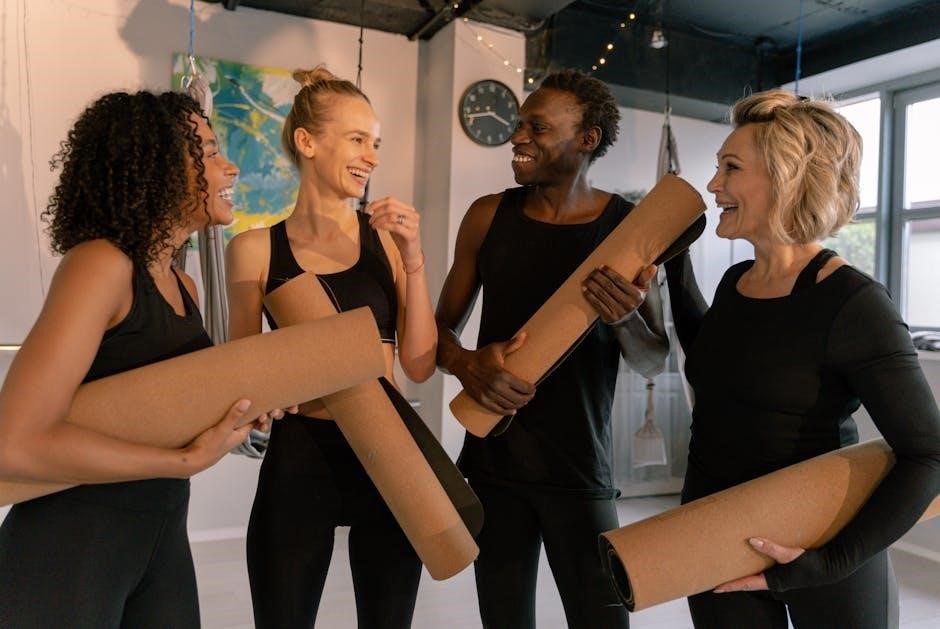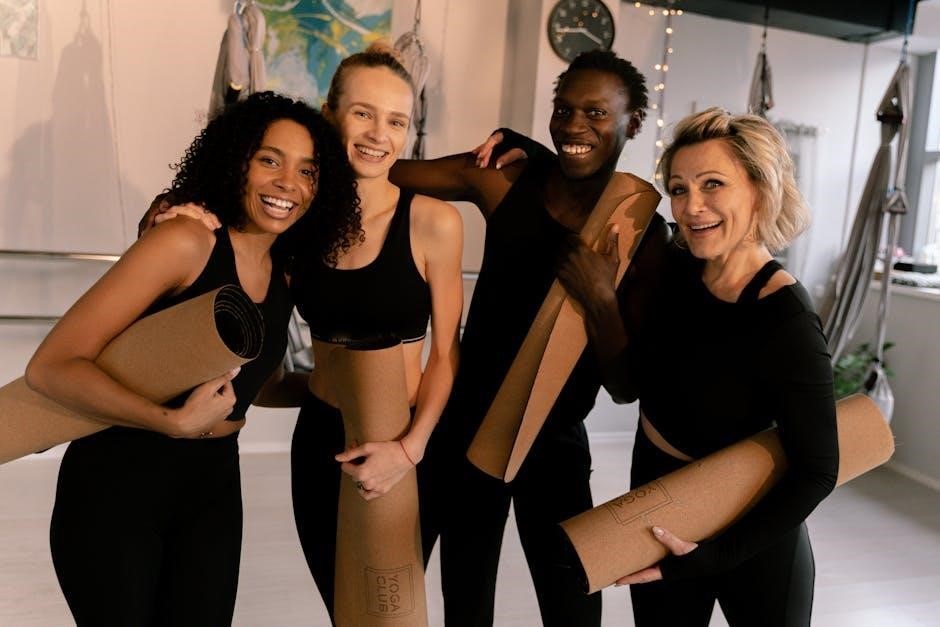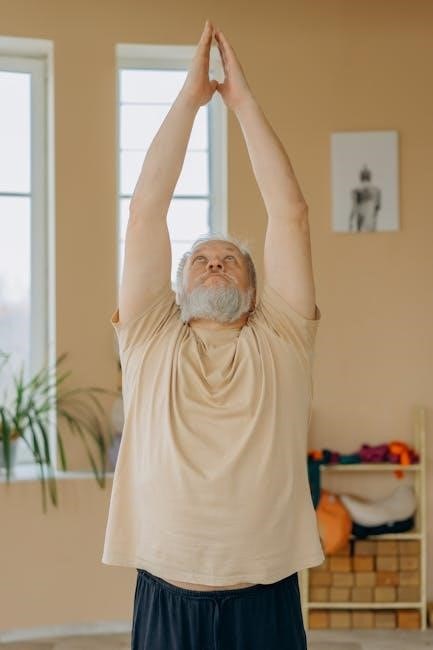60-Minute Yoga Sequence PDF: A Comprehensive Guide
Embark on a transformative journey with our comprehensive guide to 60-minute yoga sequences. This resource offers curated flows suitable for various levels, providing a pathway to enhance wellness, improve flexibility, and cultivate inner peace through consistent practice.

In today’s fast-paced world, carving out time for self-care is essential. A 60-minute yoga sequence provides a structured and accessible way to incorporate physical activity, mindfulness, and stress reduction into your daily routine. These sequences offer a balanced practice, incorporating various poses (asanas), breathwork (pranayama), and a final relaxation period (Savasana).
This guide explores the concept of 60-minute yoga sequences, delving into different styles like Hatha, Vinyasa, Restorative, and Power Yoga. It aims to empower individuals to create or follow sequences that align with their fitness levels, personal goals, and time constraints; Whether you’re a beginner or an experienced yogi, understanding the principles behind sequencing is crucial for a safe and effective practice.
We’ll discuss the importance of warming up, building to a peak pose, and cooling down properly. Additionally, we’ll highlight the benefits of each style, offering tailored sequences in PDF format for easy access and home practice. Get ready to unlock the potential of a consistent 60-minute yoga routine.
Benefits of a 60-Minute Yoga Practice
Engaging in a 60-minute yoga practice offers a multitude of benefits that extend far beyond physical flexibility. Regular practice can significantly improve strength, balance, and cardiovascular health. Specific poses target different muscle groups, promoting overall toning and endurance.
Beyond the physical, yoga profoundly impacts mental and emotional well-being. The focused breathing techniques (pranayama) calm the nervous system, reducing stress hormones like cortisol. This leads to increased feelings of relaxation, improved mood, and enhanced sleep quality. A consistent yoga practice can also cultivate mindfulness, fostering a greater awareness of the present moment and reducing mental chatter.
Furthermore, yoga can improve posture, alleviate chronic pain, and increase body awareness. It encourages a deeper connection between mind and body, promoting self-acceptance and a sense of inner peace. Whether you seek physical fitness, stress relief, or emotional balance, incorporating a 60-minute yoga sequence into your routine can be a powerful tool for holistic well-being. The time invested yields lasting positive effects on your overall health and vitality.
Hatha Yoga Sequence for Beginners (60 Minutes)
This 60-minute Hatha yoga sequence is designed specifically for beginners, focusing on foundational poses and gentle movements. The sequence prioritizes proper alignment and breathwork, ensuring a safe and effective practice. It begins with a centering exercise to calm the mind, followed by gentle warm-ups like neck rolls and wrist rotations.
The core of the sequence includes basic poses such as mountain pose (Tadasana), downward-facing dog (Adho Mukha Svanasana), and child’s pose (Balasana). Modifications are provided to accommodate varying levels of flexibility. Each pose is held for several breaths, allowing beginners to deepen their awareness of their body and breath.
The sequence also incorporates gentle stretches and twists to improve flexibility and release tension. It concludes with a restorative Savasana (corpse pose) for deep relaxation. This Hatha yoga sequence aims to build a solid foundation in yoga, promoting strength, flexibility, and mindfulness in a supportive and accessible manner. Remember to listen to your body and modify poses as needed.
Vinyasa Yoga Sequence (60 Minutes)
This 60-minute Vinyasa yoga sequence is designed to synchronize breath with movement, creating a dynamic and flowing practice. The sequence begins with sun salutations (Surya Namaskar A and B) to warm up the body and build heat. Transitions between poses are fluid and intentional, fostering a sense of continuity.
The core of the sequence includes a variety of standing poses, such as warrior poses (Virabhadrasana I, II, and III), triangle pose (Trikonasana), and side angle pose (Parsvakonasana). These poses build strength, improve balance, and increase flexibility. The sequence also incorporates twists, backbends, and inversions to challenge the body and mind.
Modifications are offered for different levels of experience. Throughout the practice, emphasis is placed on mindful breathing and proper alignment. The sequence concludes with a cool-down period, including seated stretches and a final Savasana for relaxation and integration. This Vinyasa sequence aims to cultivate strength, flexibility, and mindfulness through a dynamic and invigorating practice. Remember to listen to your body and adjust the poses as needed.
Restorative Yoga Sequence (60 Minutes)
This 60-minute Restorative yoga sequence is designed to promote deep relaxation and stress reduction. It utilizes props such as blankets, bolsters, and blocks to support the body in passive poses, allowing for complete surrender and release. The sequence begins with a grounding pose like Supported Child’s Pose, fostering a sense of safety and comfort.
Each pose is held for an extended period, typically 5-10 minutes, allowing the body to fully relax and the mind to quiet. Gentle twists, such as Supported Reclining Twist, aid in detoxification and release tension in the spine. Heart-opening poses, like Supported Bridge Pose or Supported Fish Pose, promote emotional release and feelings of well-being.
The sequence concludes with a long and blissful Savasana, ideally 10-15 minutes, allowing for complete integration of the practice. Throughout the sequence, focus on gentle breathing and mindful awareness of the body. This Restorative yoga sequence aims to calm the nervous system, reduce anxiety, and promote deep relaxation. Remember to adjust the props and poses to suit your individual needs and comfort level.

Power Yoga Sequence (60 Minutes)
This 60-minute Power Yoga sequence is designed to build strength, increase stamina, and cultivate mental focus. This dynamic practice incorporates a series of challenging poses linked together with breath, creating a flowing and invigorating experience. The sequence typically begins with a warm-up, including sun salutations to build heat and prepare the body for more intense poses.
Standing poses, such as Warrior II, Triangle Pose, and Side Angle Pose, are held for several breaths to strengthen the legs and core. Arm balances, such as Crow Pose or Side Crow Pose, can be incorporated to challenge strength and coordination. Core work, including boat pose variations and planks, is essential for building stability and power.
Inversions, such as shoulder stand or headstand, may be included for advanced practitioners, offering numerous physical and mental benefits. The sequence concludes with a cool-down, including gentle stretches and a restful Savasana. Throughout the practice, focus on maintaining proper alignment, engaging the core, and connecting with your breath. This Power Yoga sequence aims to challenge your physical limits, build mental resilience, and leave you feeling energized and empowered.
Adapting the Sequence for Different Levels
Adapting a 60-minute yoga sequence is crucial for catering to practitioners of varying abilities. For beginners, prioritize a slower pace, simpler poses, and extended holds in each asana, emphasizing proper alignment and breath awareness. Modifications are essential; utilize props like blocks, straps, and blankets to support accessibility and prevent injury. Intermediate practitioners can explore more challenging variations of poses, gradually increasing the duration of holds.
Advanced yogis might incorporate advanced poses, such as inversions or arm balances, while focusing on refining their alignment and deepening their breath control. Encourage students to listen to their bodies and modify poses as needed, honoring their individual limitations and capabilities. Provide options for each pose, allowing individuals to choose the variation that best suits their current level.
Offer modifications for common injuries or physical limitations, ensuring inclusivity and safety for all participants. Remind participants to avoid pushing themselves beyond their limits and to prioritize proper form over achieving the full expression of a pose. By offering a range of modifications and variations, you can create a yoga class that is both challenging and accessible for students of all levels.
Key Poses and Their Modifications
Understanding key yoga poses and their modifications is essential for a safe and effective 60-minute practice. Downward-facing dog (Adho Mukha Svanasana) is a foundational pose that can be modified by bending the knees or placing hands on blocks. Warrior poses (Virabhadrasana I, II, III) can be adapted by shortening the stance or modifying arm positions. Triangle pose (Trikonasana) can be adjusted by using a block to support the lower hand.
For seated forward folds like Paschimottanasana, bending the knees allows for a more accessible stretch. Backbends such as Cobra pose (Bhujangasana) can be modified by lowering the chest or placing hands further forward. Inversions like Shoulder stand (Sarvangasana) should be approached with caution, offering supported variations using blankets or bolsters.
Always prioritize proper alignment and breath control over achieving the full expression of a pose. Encourage students to listen to their bodies and modify poses as needed, honoring their individual limitations and capabilities. Provide verbal cues and demonstrations to guide students through the modifications, ensuring a safe and enjoyable practice for all. By understanding these key poses and their modifications, practitioners can adapt their practice to suit their individual needs and abilities.
Importance of Breathwork (Pranayama)
Breathwork, or Pranayama, is an integral aspect of any yoga practice, especially within a 60-minute sequence. Integrating Pranayama techniques enhances the physical postures, fostering a deeper connection between mind and body. Ujjayi breath, also known as the “ocean breath,” is a common technique used throughout Vinyasa and Hatha practices, promoting focus and calming the nervous system.
Kapalabhati, or skull-shining breath, can be incorporated at the beginning of the sequence to invigorate the body and clear the mind. Nadi Shodhana, or alternate nostril breathing, is beneficial for balancing the energy channels and promoting relaxation. Bhramari, or bumblebee breath, can be used towards the end of the sequence to soothe the mind and relieve stress.
By consciously controlling and manipulating the breath, practitioners can regulate their heart rate, lower blood pressure, and reduce anxiety. Emphasize the importance of breathing fully and deeply throughout the practice, allowing the breath to guide movement and deepen stretches. Encourage students to remain present with their breath, using it as an anchor to stay grounded in the moment. Integrating Pranayama into a 60-minute yoga sequence enhances its therapeutic benefits, promoting overall well-being.

Cool-Down and Relaxation (Savasana)
The cool-down and relaxation phase, culminating in Savasana, is a crucial component of any 60-minute yoga sequence. It allows the body to gradually return to its resting state, integrating the physical and energetic benefits of the practice. Gentle stretches, such as reclined twists and supine hamstring stretches, can ease muscle tension and prepare the body for complete relaxation.
Savasana, or corpse pose, is the final resting posture, typically held for 5-10 minutes. Creating a comfortable environment with soft lighting, blankets, and eye pillows can enhance the experience. Encourage students to release all muscular tension, surrendering completely to gravity. Focus on deep, slow breaths, allowing the mind to quiet and settle.
Guiding students through a body scan meditation can further promote relaxation, encouraging them to notice and release any remaining tension. Gentle music or nature sounds can create a calming atmosphere. Emphasize the importance of stillness and allowing the body to fully absorb the practice. Savasana is not merely a resting pose; it is an active process of integration, allowing the nervous system to reset and the mind to find peace. Concluding the 60-minute sequence with a mindful Savasana maximizes its restorative effects.
Creating Your Own 60-Minute Yoga Sequence
Crafting a personalized 60-minute yoga sequence allows you to tailor your practice to your specific needs and goals. Begin by identifying your intention for the practice, whether it’s to increase flexibility, build strength, reduce stress, or simply cultivate mindfulness. Consider your current physical condition and any limitations you may have, ensuring that the sequence is safe and accessible.
Structure your sequence with a clear beginning, middle, and end. Start with a warm-up to prepare the body for deeper stretches and poses. Include sun salutations or gentle movements to increase blood flow and flexibility. The main body of the sequence should incorporate a variety of poses that target different muscle groups and energy centers. Integrate standing poses for strength and balance, seated poses for flexibility and grounding, and inversions for energy and perspective.
Remember to balance effort with ease, incorporating restorative poses and modifications as needed. Prioritize proper alignment and breathwork throughout the sequence, ensuring that each pose is performed with awareness and control. Conclude with a cool-down and relaxation phase, including gentle stretches and Savasana. Regularly evaluate and adjust your sequence based on your progress and evolving needs, allowing your practice to remain dynamic and fulfilling.
Free Resources and PDF Downloads

Unlock a treasure trove of free resources and PDF downloads designed to enhance your yoga journey. Access expertly crafted 60-minute yoga sequences tailored for various levels, from beginners to advanced practitioners. These downloadable PDFs provide clear instructions and visual guides, making it easy to follow along at your own pace in the comfort of your own space.
Explore a variety of yoga styles, including Hatha, Vinyasa, Restorative, and Power Yoga, with sequences designed to meet your specific needs and preferences. Discover free audio classes that complement the PDF sequences, guiding you through each pose with mindful instruction and breath cues. Take advantage of free monthly yoga sequences that incorporate Ayurvedic principles, helping you manage your energy flow and promote overall well-being.
Utilize online yoga sequence builders to easily plan and customize your own practices, accessing a vast library of yoga poses and pre-made lesson plans. Enhance your teaching skills with ready-to-teach twisting sequences and digital downloads centered around specific poses. These free resources empower you to deepen your understanding of yoga and create fulfilling and transformative practices.
